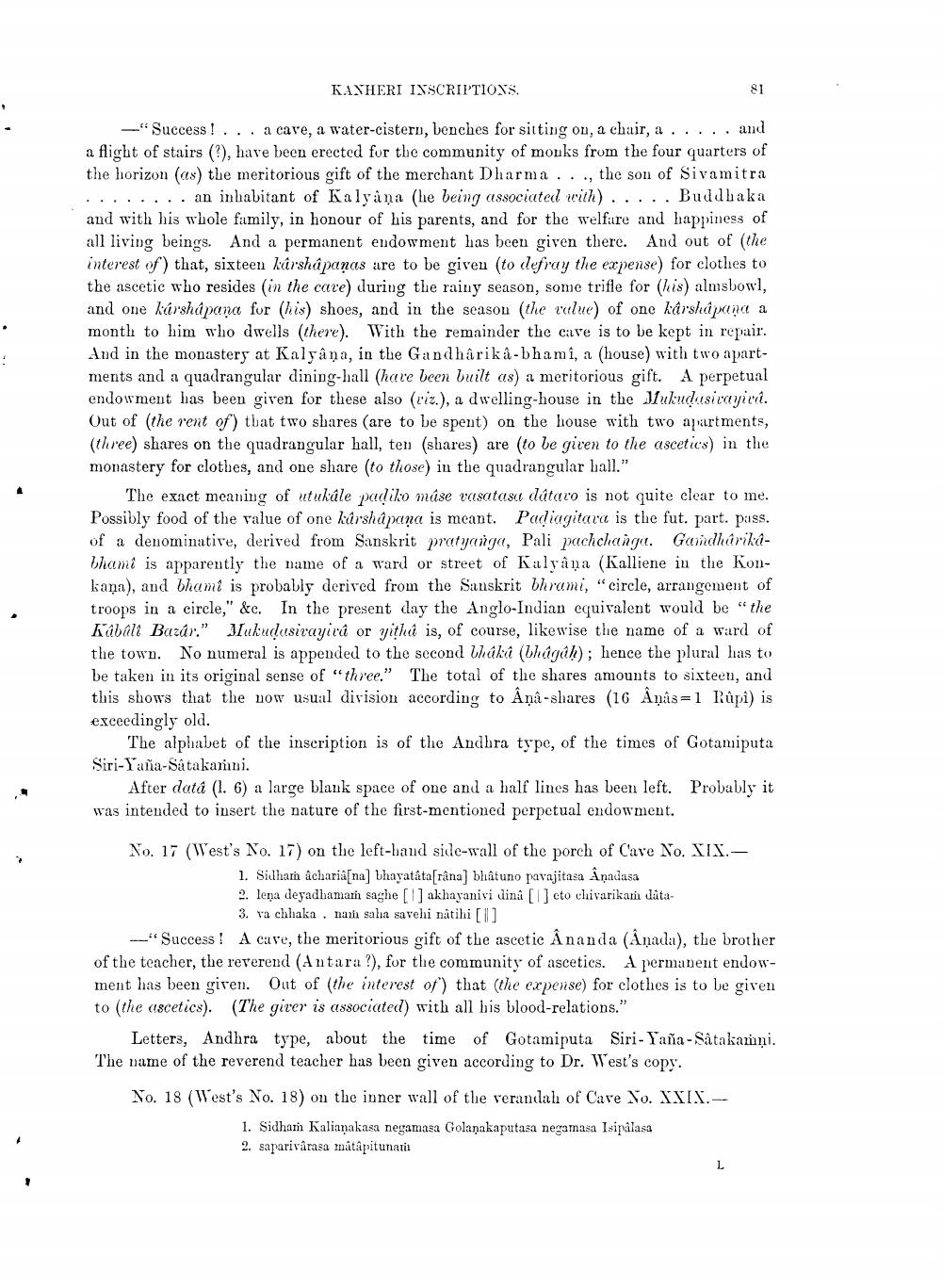________________
KAXHERI IXSCRIPTIONS.
81
- Success! ... a cave, a water-cistern, benches for sitting on, a chair, a ..... and a flight of stairs (?), have been erected for the community of mouks from the four quarters of the horizon (as) the meritorious gift of the merchant Dharma . . ., the son of Sivamitra ........ an inhabitant of Kalyaņa (he being associated with)..... Buddhaka and with his whole family, in honour of his parents, and for the welfare and happiness of all living beings. And a permanent endowment has been given there. And out of the interest of) that, sixteen kárshápaņas are to be given to defray the expense) for clothes to the ascetic who resides (in the cave) during the rainy season, some trifle for (is) almsbowl, and one kárshápana for (his) shoes, and in the season (the value) of one kárshápana a month to him who dwells (there). With the remainder the cave is to be kept in repair. And in the monastery at Kalyâņa, in the Gandhårikå-bhamî, a (house) with two apartments and a quadrangular dining-hall (hare been built as) a meritorious gift. A perpetual endowment has been given for these also (riz.), a dwelling-house in the Jukudusi vayici. Out of the rent of) that two shares (are to be spent) on the house with two apartments, (three) shares on the quadrangular hall, ten (shares) are (to be given to the ascetics) in the monastery for clothes, and one share (to those) in the quadrangular ball."
The exact meaning of utukále padiko máse vasatasu dátaro is not quite clear to me. Possibly food of the value of one kúrshapana is meant. Padiagitara is the fut. part. pass. of a denominative, derived from Sanskrit pratyanga, Pali pachchanga. Gandhárikathami is apparently the name of a ward or street of Kalyana (Kalliene in the Konkana), and bhami is probably derived from the Sanskrit bhrami, "circle, arrangement of troops in a circle," &c. In the present day the Anglo-Indian cquivalent would be "the Kúbali Bazár." Jukudusivayirâ or yithe is, of course, likewise the name of a ward of the town. No numeral is appended to the second tháki (Thágah); hence the plural has to be taken in its original sense of "three." The total of the shares amounts to sixteen, and this shows that the now usual division according to Âņa-shares (16 Âņas=1 Rûpî) is exceedingly old.
The alphabet of the inscription is of the Andhra type, of the times of Gotamiputa Siri-Yana-Så takanni.
After data (1. 6) a large blank space of one and a half lines has been left. Probally it was intended to insert the nature of the first-mentioned perpetual endowment.
No. 17 (West's No. 17) on the left-hand side-wall of the porch of Cave No. XIX.
1. Sidhar acharia[na] Whayatâta[râna) bhâtuno pavajitasa Ânadasa 2. lena deyadhamam saghe [] akhayanivi dina [1] eto chivarikat data
3. va chhaka , hari saha savehi natihi [1] --"Success! A cuve, the meritorious gift of the ascetic Ananda (Anada), the brother of the teacher, the reverend (Antara?), for the community of ascetics. A permanent endowment has been given. Out of the interest of that the expense) for clothes is to be given to (the ascetics). (The giver is associated with all his blood-relations."
Letters, Andhra type, about the time of Gotamiputa Siri- Yana-Satakanņi. The name of the reverend teacher has been given according to Dr. West's copy. No. 18 (West's No. 18) on the inner wall of the verandal of Cave No. XXIX. --
1. Sidhan Kalianakasa negamasa Golanakaputasa negamasa Isipilasa 2. saparivarasa matapitunati




